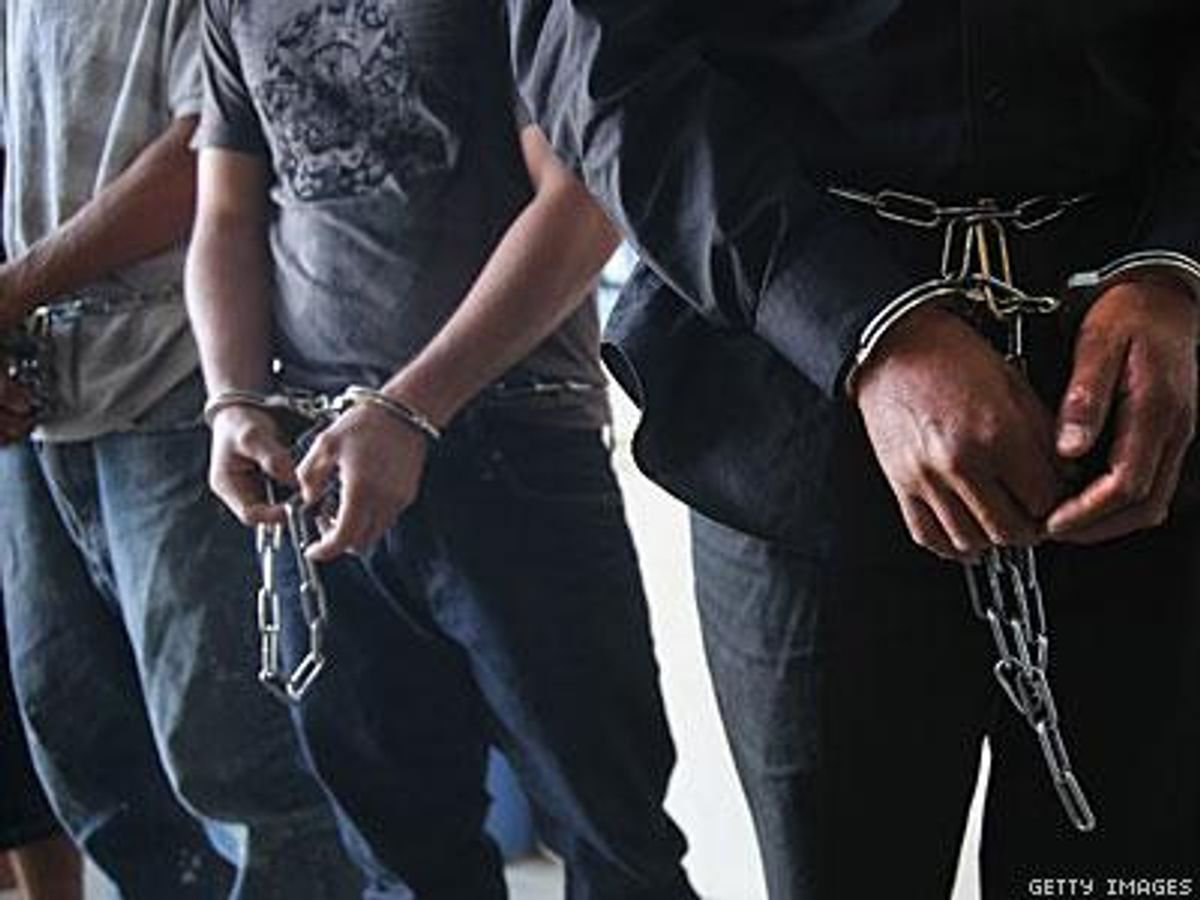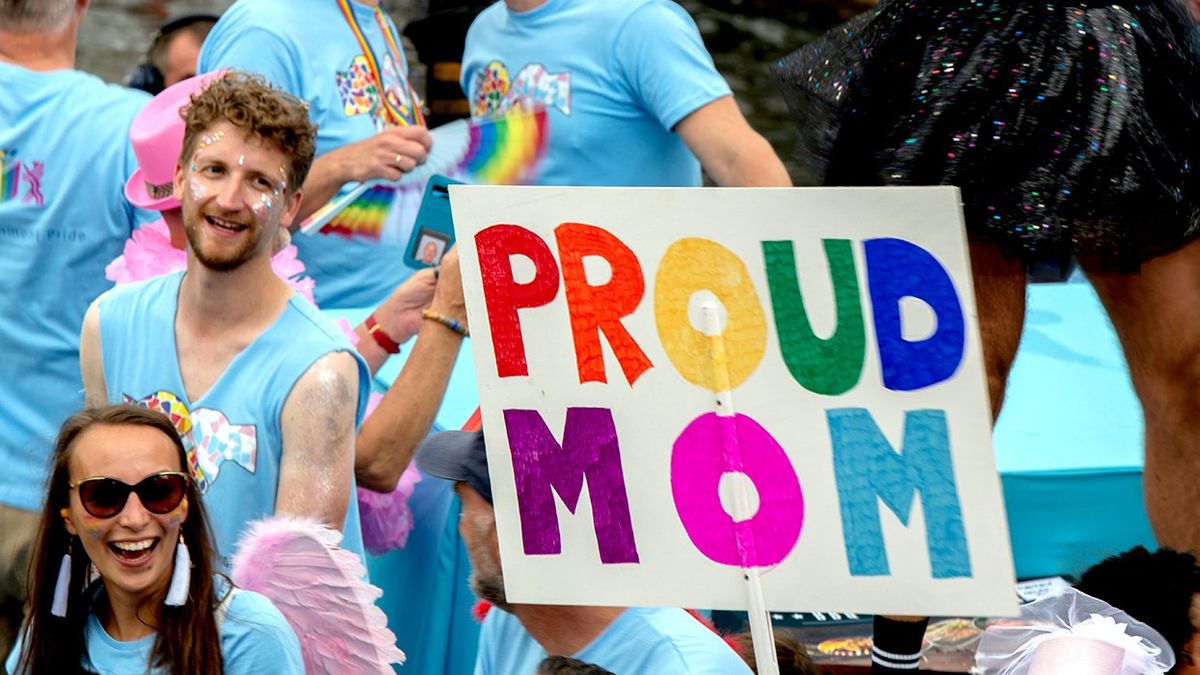The Department of Homeland Security has new guidelines on detaining LGBT immigrants, but activists warn the rules could be doing more harm than good.
DHS released the new set of regulations last month designed to prevent sexual abuse within immigration detention facilities. They were drafted in response to the Obama administration's decision in May 2012 that the the Prison Rape Elimination Act of 2003 would apply to DHS immigration detention centers. After pushback from DHS officials, the Obama administration agreed to allow DHS to craft its own policy.
"DHS is committed to upholding a culture that promotes safety and refuses to tolerate abuse," DHS Secretary Jeh Johnson said in a release last month. "This rule will strengthen standards in DHS confinement facilities and ensure robust oversight."
Many immigration and civil rights groups lauded the announcement. Ruthie Epstein, a legislative policy analyst at the American Civil Liberties Union, expressed optimism in a statement to the Huffington Post.
"We're hopeful that it will provide strong protections for immigrants held in [Immigration and Customs Enforcement] or [Customs and Border Protection] custody, who too often fear retaliation, including deportation, for reporting sexual assault or abuse," Epstein said, calling the policy change "long overdue."
Still, not all groups came away with such positive feelings toward the new standards. In a joint release with the Transgender Law Center, National Center for Transgender Equality director of policy Harper Jean Tobin called the announcement "a tremendous missed opportunity which adds urgency to ending our multibillion-dollar mass incarceration of immigrants." Tobin continued, "The lack of adequate protections for transgender immigrants in particular makes it clear that these vulnerable individuals are not safe in detention facilities and should no longer be detained."
So which is it? Are these new regulations up to par -- as the ACLU has put forth -- or does it leave LGBT detainees with the same, elevated risk of danger they've always faced?
When reached for comment by The Advocate, a spokesperson with DHS noted that the new rule builds on existing guidelines: regulating searches of transgender detainees in an effort to ensure they are not used to harass or discriminate against those in custody, requiring additional documentation and repeated approval before placing and for keeping a detainee in solitary confinement, and requiring that such strategies are to be used only as a "last resort" when no other safe, viable housing options are available for a person who may be at risk for sexual assault because of their sexual orientation or gender identity.
The spokesperson also confirmed that under the new rule, a detainee's self-identification regarding gender and safety needs must be taken into consideration when determining placement, and that physical anatomy or identification documents may not be the sole consideration in such placements. Ultimately, the DHS official asserted that all of the department's regulations are now as protective -- or in some cases more protective -- than current federal regulations that govern conditions in criminal confinement.
"The new regulation, which builds on existing DHS detention policies and practices, strengthens the safety and humane detention of all individuals held in our facilities," deputy press secretary Marsha Catron tells The Advocate.
But NCTE executive director Mara Keisling doesn't believe that's the case.
Her organization took advantage of the pending rule's review comment period, raising issues which she argues are not fully addressed by the final rule. Keisling spoke with The Advocate in an effort to clarify the organization's concerns, and elaborate on her desire to see an increased level of awareness around the issues facing trans and gender-nonconforming immigrants when they encounter DHS. An edited transcript follows.
 At left: Mara Keisling
At left: Mara Keisling
The Advocate: Last month, the Department of Homeland Security released new standards supposedly in line with the protectitons offered by Prison Rape Elimination Act. NCTE seems to believe otherwise. How did DHS miss the mark?
Mara Keisling: Sexual abuse of trans and gay detainees is just out of control. Congress intended to end sexual abuse in jails and prisons, including immigration detention.
When the Prison Rape Elimination Act rules came out, DHS said, "Whoa, whoa, whoa. This doesn't apply to us. We can't have the Department of Justice telling us what to do." It's a straight-up turf thing. So, after a lot of clamor, the White House said to the DHS, "OK, you have to come up with your own rules." What they came up with were much weaker rules than apply to jails and prisons in the United States. Even though a lot of immigration detention is done in the same jails, and prisons, DHS considers themselves exceptional, and didn't want to fully protect people from sexual abuse, which is just shameful.
That being said, [now the] DHS final rules are out, and they are grossly inadequate. They just reinforce the really strong belief that immigration detention cannot safely house trans inmates...
There are so many alternatives to detention that could be used while waiting for asylum hearings, for deportation, for anything. There are alternatives like house arrest with ankle bracelets. Now, we're not in the business of recommending ankle bracelets, but if people are going to be put into situations where authorities don't want to protect them from frequent sexual assault, maybe ankle bracelets are the right way to go.
Would you say it seems like DHS doesn't understand the problem -- or rather, that they don't care to understand the problem?
I think that's it. They understand it. They've seen the congressional research study that shows that 40 percent of all sexual assaults in immigration detention aren't reported. Twenty percent of the allegations that are substantiated are found to have involved transgender victims. They know that their average solitary confinement stay is just under 30 days... unless you're a gay person or a transgender person, in which case it's over 200 days in solitary confinement on average. They know all that. They know they cannot safely house trans inmates.
One of the other problems they have is the bed mandate. Are you familiar with that?
I'm not, actually.
It is one of the most immoral things happening in America right now. There's a bed quota. Over the past number of years, Republicans have insisted on more and more money being allocated to immigration detention beds to prove they were being "tough enforcement people." Currently, in the president's 2015 budget, he's proposed $2 billion in bed quotas. It requires immigration detention facilities to fill 34,000 beds every night. They have to fill these beds every night.
It's heartbreaking when you watch TV, and you see some American kid hiking on the border of North and South Korea, and suddenly they're missing, and the parents are all torn apart. "Oh, our daughter is missing. She's so great. Everyone likes her. We don't have any idea where she is," and we just call up the North Korean authorities to get her back. You hear that story on the news, but you don't hear that happens every night in the United States, and it's us doing it. When we put people in detention because there's a bed quota, we don't care when the people we're forcing into this mess are sexually assaulted.
We've all heard the dangerous argument that "maybe we should put LGBT people in solitary confinement for their own safety." From what I understand, solitary can have mental and physical health risks. Now that DHS has released their final standards, is there anything that can be done, or is this final?
Yes, there's always things that can be done. There's a section in this rule, 115.42(b), and all it does is codify something they did in 2011 in their detention centers: it said decisions on housing in immigration detention centers cannot on the basis of just physical anatomy. You can't say, "Oh, you have a penis? You're a man." Or, "Oh, your Mexican passport says male? You're a man." Instead, it has to be made on a case-by-case basis that takes into account self-identification, a self-assessment of safety, and common sense. The way it's written in these new rules makes it clear that this is about all housing decisions, including whether to place people into a male or female facility, but it's just not enforced.
As far as we know, every transgender woman in immigration detention is housed with men.
I was in California at one of their detention centers, southwest of Los Angeles. There, they have an "LGBT pod," where they house LGBT people. These pods have been ruled dangerous and unhelpful. They've been disallowed in the [Department of Justice] world, but DHS wanted to do it.
 At left: An immigrant detainee makes a call from his 'segregation cell' at the Adelanto Detention Facility in Adelanto, California. Guards said he had been put in solitary confinement for fighting with another inmate.
At left: An immigrant detainee makes a call from his 'segregation cell' at the Adelanto Detention Facility in Adelanto, California. Guards said he had been put in solitary confinement for fighting with another inmate.This whole idea -- of housing trans women in men's facilities, and creating "pods" -- seems unsafe. Wouldn't the Eighth Amendment, which protects against cruel and unusual punishment, preclude these rules? Putting someone in solitary confinement for eight or nine months seems like it might fall under that. As this is an immigration issue, does that apply?
Most studies about solitary confinement show that at about two weeks, you're causing lasting medical and mental health harm. Everybody knows that, and that's the science of it. DHS is saying, "We think the presumptive limit should be 30 days," which is twice that long. Then they don't follow it, anyway. That rule doesn't apply to contract facilities. They know what the science is, but they don't care.
That is both sad and scary -- that the science is out there, that research has been put into this, but DHS doesn't seem to care.
The reason we care about this at NCTE is multifaceted. We do believe that if injustice is allowed to happen, it's going to also happen to trans people. All injustice is bad on its own, and bad because it's used against trans people more than other people. In this particular case, it's being used against trans people just because they're trans. Remember, a huge percentage of trans immigrants who are in detention came to this country because they were trans, and because they weren't safe in their own country.
These are people who were persecuted, raped, or not allowed to work because they're trans. They come to the United States where they face discrimination and violence because they're trans, and because they're immigrants, obviously. Then they go into immigration detention where they face elevated risk of sexual assault. They're housed wrong because they're trans. ... This is very much a trans issue because it's the "transness" of the people that are causing them to be abused throughout their lives -- whether it's abuse they face in their home country, or the abuse they face in a detention facility.
It really seems as though there's no escape for these people. They face discrimination back home, they face it here. What can be done to change this?
A lot of our people simply don't know about the system we have in place, and they don't understand it. We have these arbitrary 34,000 beds that ICE is just required to fill each night. It doesn't make any sense.
It's all about politics. It's all about some struggle between Republicans and Democrats, and people trying to look "strong against immigration" or people trying to be "reasonable compromisers." But this isn't about one or two people getting screwed. This is 34,000 people being torn from their families, with some of them being sexually assaulted, put in solitary confinement -- and most people don't even know this is a thing.
When I was at the Santa Ana detention center in California, I was standing with a couple guards, and we were standing in this LGBT pod. I looked around, and it looked like it was completely made up of gay men and transgender women. I said, "It looks like there's not a lot of gay women here." The guard said, "That's right, it's just gay men." I said, "Yes, and transgender women." He said, "Yes, all kinds of gay men."
I think that comes from how they feel about transgender people: "They're just gay men." It leads to all these horrible things.
Anytime I hear the tired, overplayed idea that transgender women are simply an extension of gay men, as though we're just so gay that we switched our gender, it irks me. For one, as a transgender woman who isn't at all into men, that's clearly not true. I think that's where a lot of these problems stem from: that transgender women are just men who have hit some sort of critical mass of gayness. This reinforces the idea that our gender -- our identity as human beings -- boils down to nothing more than a performance that we could dial back if we wanted. It's pervasive. The assertion that transgender women aren't actually women builds stereotypes. What are your thoughts on this?
Yep. I completely agree. This should irk you.
We had this one woman who came into our office. She was picked up in a somewhat random traffic stop situation. It wasn't an accident, and there weren't any drugs or alcohol. She was picked up and put in immigration detention. She asked for an asylum hearing. In the meantime, she was put in solitary confinement for nine months to wait. After a few months, she got word that her mother was about to die, so she asked if she could go see her mother, and they said, "No." Her mother died a couple days later.
In her one hour every day in the yard -- the recreation area -- she was crying. Another detainee asked her what was wrong, and she explained that her mother had died, and she wasn't allowed to go see her. The woman hugged her, and they both lost their one hour privileges for a month for touching another inmate. At the end of the nine months, she was driven to a courthouse for a hearing. The hearing lasted five minutes, and the judge said, "Yep, you're a good case for asylum. We'll let you out." She was put in solitary confinement for nine months before she was able to get this five minute hearing that would have released her.
But hey, she helped them meet the bed quota.
































 At left: Mara Keisling
At left: Mara Keisling At left: An immigrant detainee makes a call from his 'segregation cell' at the Adelanto Detention Facility in Adelanto, California. Guards said he had been put in solitary confinement for fighting with another inmate.
At left: An immigrant detainee makes a call from his 'segregation cell' at the Adelanto Detention Facility in Adelanto, California. Guards said he had been put in solitary confinement for fighting with another inmate.

















































